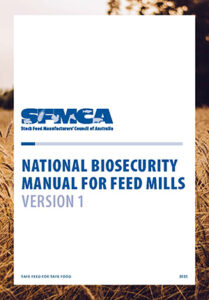Read the latest information on
Foot-and-mouth disease

Manuals are excellent training tools when inducting new staff who may need to be briefed about on-farm biosecurity
The Farm Biosecurity website makes it easy for producers seeking advice on the biosecurity measures to implement on their property. With free resources for 24 industries, there’s likely to be tailored information to suit most producers.
Plant Health Australia’s General Manager, Partnerships, Mr Rod Turner, said manuals contain all the measures that can be used to reduce the risks of diseases entering or spreading on your farm.
“Manuals are developed in consultation with industry bodies, researchers and government agencies. Most of the manuals include the same general topics – framed around the six essentials – with headings like people, vehicles and equipment, inputs, outputs and production practices,” said Mr Turner.
“Because every farm is different, you’ll find general recommendations about what to implement, an explanation why it’s important, and suggestions as to how.”
“Even if you are familiar with the biosecurity practices for your industry, the manuals are also excellent training tools when inducting new staff who may need to be briefed about on-farm biosecurity.”
The biosecurity checklists in manuals are particularly useful so you can be sure that nothing has been overlooked when implementing biosecurity measures.
Manuals also include a wide variety of templates for record sheets, which have been extracted and are available as separate files on the website, so you can download and just printout and use the few pages that you need.
This is useful for things that you do often and need to be recorded, like cleaning equipment, registering the source of inputs and delivery dates, logging farm visitors, pest surveillance and monitoring for pests and diseases, vehicle cleaning and so on.
 A recent addition to the Farm Biosecurity suite of manuals is the National Biosecurity Manual for Feed Mills, produced by the Stock Feed Manufacturers’ Council of Australia (SFMCA).
A recent addition to the Farm Biosecurity suite of manuals is the National Biosecurity Manual for Feed Mills, produced by the Stock Feed Manufacturers’ Council of Australia (SFMCA).
The biosecurity checklist that’s part of the manual is also available as a separate resource.
Feed manufacturing and delivery is a fundamental part of the production chain and having good biosecurity practices in this area will help to reduce the risk of disease spread.
Executive Officer for the SFMCA, Mr Duncan Rowland, said the manual was a key tool for producers interested in implementing and performing sound biosecurity practices on their property.
“This manual has been produced to assist feed mills in translating biosecurity practices into operating procedures and work instructions,” said Mr Rowland.
The guidelines were developed based on information provided by industry and in conjunction with the SFMCA and the FeedSafe® Feed Mill Hygiene Guidelines.
“Biosecurity practices in the feed mill protect livestock against exposure to endemic and emergency diseases via the manufacture and delivery of feed. They also aim to limit the spread of these diseases within livestock and – in the case of zoonotic diseases – human populations.
Whether they are clinical (obvious) or subclinical (hidden), infectious diseases can significantly reduce the productivity, profitability and long-term financial viability of livestock enterprises.
“Biosecurity in the feed mill also includes preventing the spread of diseases, pests and weeds to or from other primary industries, for example grain crops and horticulture,” said Mr Rowland.
The documents are listed on the Manuals page.
To create your own biosecurity toolkit, you can also go to the profiler, select the crops and livestock that apply to you and ‘Save your farm profile’.